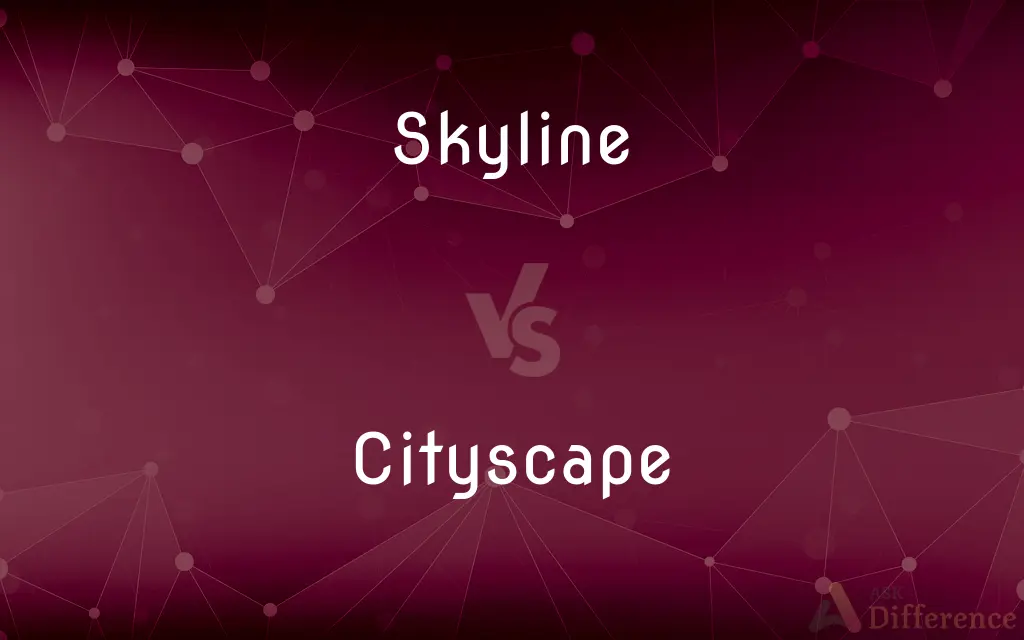Skyline vs. Cityscape — What's the Difference?
By Tayyaba Rehman & Fiza Rafique — Updated on April 16, 2024
Skyline refers to the silhouette of a city's buildings against the sky, while cityscape encompasses a broader view of an urban area, including streets and activity.

Difference Between Skyline and Cityscape
Table of Contents
ADVERTISEMENT
Key Differences
A skyline typically features the outlines of a city's tallest and most distinctive buildings, capturing their heights and architectural silhouettes. On the other hand, a cityscape provides a more comprehensive view that includes various elements of the urban environment beyond just the buildings.
Skyline images often emphasize the aesthetic arrangement of skyscrapers and are popular in photographs taken at dusk or dawn when the sky contrasts sharply with building silhouettes. Cityscapes, meanwhile, might capture day-to-day urban life, incorporating people, transportation, and street scenes.
When discussing skylines, the focus tends to be on the impact of the city's vertical architecture and how it defines the city's identity from a distance. Cityscapes, by contrast, delve into the urban texture, offering insights into the city's layout, density, and functional zones.
The term skyline is frequently used in contexts where the aesthetic or iconic stature of a city is discussed, such as in tourism or real estate. Cityscapes are more often utilized in urban planning and architectural contexts to discuss spatial relationships and infrastructure.
The appreciation of a skyline can be somewhat static, focusing on the form and outline of buildings against the sky. Cityscapes offer a dynamic view that reflects the vibrancy and activity of urban life, including both static structures and moving elements.
ADVERTISEMENT
Comparison Chart
Definition
Outline of city buildings against the sky
Comprehensive view of urban area, including buildings, streets, and activity
Focus
Aesthetic arrangement of buildings
Broader urban environment and lifestyle
Typical Usage
Tourism, real estate
Urban planning, architecture
Visual Elements
Building heights and silhouettes
Buildings, streets, people, transportation
Context
Often viewed from a distance
Viewed both from a distance and within
Compare with Definitions
Skyline
The visible outline of a city's buildings against the sky.
The New York skyline is instantly recognizable worldwide.
Cityscape
The urban environment as seen in a comprehensive view.
From the tower, the cityscape stretches into the suburbs.
Skyline
A panoramic view emphasizing a city's tallest structures.
The skyline from the river is breathtaking during sunrise.
Cityscape
A depiction of city life and infrastructure.
Documentaries may explore the cityscape to discuss urban development.
Skyline
A distinctive feature of urban landscapes.
Postcards often feature a city's skyline.
Cityscape
The visual appearance of an urban area.
His paintings depict the gritty cityscape of mid-century Chicago.
Skyline
A horizon formed by city buildings.
The skyline was lit by the setting sun.
Cityscape
The layout and visible features of a city.
The cityscape includes bustling streets and quiet neighborhoods.
Skyline
The overall shape or image presented by a city's skyscrapers and high-rise buildings.
The evolving skyline reflects the city's economic growth.
Cityscape
A genre of artistic representation that shows a city.
Photographers capturing the cityscape focus on integrating human elements.
Skyline
A skyline is the outline or shape viewed near the horizon. It can be created by a city's overall structure, or by human intervention in a rural setting, or in nature that is formed where the sky meets buildings or the land.
Cityscape
In the visual arts, a cityscape (urban landscape) is an artistic representation, such as a painting, drawing, print or photograph, of the physical aspects of a city or urban area. It is the urban equivalent of a landscape.
Skyline
The line along which the surface of the earth and the sky appear to meet; the horizon.
Cityscape
An artistic representation, such as a painting or photograph, of a city.
Skyline
The outline of a group of buildings or a mountain range seen against the sky.
Cityscape
A city or section of a city regarded as a scene
"the vast cityscape of lower Manhattan" (New Yorker).
Skyline
(earth sciences) The line at which the earth and sky meet.
Cityscape
The view of the buildings of a city, usually referring to a pictured landscape.
Skyline
The horizontal silhouette of a city or building against the sky.
Cityscape
A viewpoint toward a city or other heavily populated area;
The dominant character of the cityscape is it poverty
Skyline
A path of movement, especially military movement, producing a silhouette above terrain features visible from the location of likely observers.
Cityscape
Painting depicting a city or urban area
Skyline
(journalism) A panel on the front page of a newspaper outlining some of the features to be found inside.
Skyline
(database) skyline operator
Skyline
To outline something against the sky.
Skyline
To filter by means of the skyline operator.
Skyline
The outline of objects seen against the sky
Skyline
The line at which the sky and Earth appear to meet
Common Curiosities
What role do cityscapes play in cultural representation?
Cityscapes play a significant role in cultural representation by showcasing the everyday urban environment and lifestyle, reflecting the cultural and social dynamics of the city.
How do skylines contribute to a city's tourism appeal?
Skylines contribute to tourism by providing iconic views that attract visitors, often becoming symbolic representations of the city itself.
How are cityscapes useful in environmental studies?
Cityscapes are useful in environmental studies for analyzing the impact of urbanization on local ecosystems and planning sustainable development.
What impact does the design of a skyline have on city residents?
The design of a skyline can affect city residents' sense of pride and identity, and it can influence the overall aesthetic appeal of the urban environment.
What techniques do urban planners use to enhance cityscapes?
Urban planners use techniques such as zoning, public space design, and architectural guidelines to enhance cityscapes, aiming to create functional and aesthetically pleasing urban environments.
How does lighting affect the perception of a skyline at night?
Lighting plays a crucial role in defining the perception of a skyline at night, highlighting architectural features and enhancing the city's visual appeal.
Why are some skylines more famous than others?
Some skylines are more famous due to the presence of iconic buildings, historical significance, and their representation in media and popular culture.
Is the skyline of a city constant?
The skyline of a city is not constant; it changes as new buildings are constructed and older ones are renovated or demolished.
Can the layout of a cityscape affect traffic patterns?
Yes, the layout of a cityscape can significantly affect traffic patterns by dictating the flow and density of traffic, influencing transportation planning and infrastructure.
What challenges do photographers face when capturing cityscapes?
Photographers capturing cityscapes face challenges such as finding the right vantage point, dealing with lighting conditions, and incorporating dynamic elements like moving traffic or people.
How do historical events shape cityscapes?
Historical events can significantly shape cityscapes by influencing architectural styles, the layout of streets, and the placement of significant monuments and buildings.
What future trends might influence the development of cityscapes and skylines?
Future trends such as technological advancements in construction, increased focus on sustainable urban development, and changes in urban lifestyle might significantly influence the development of cityscapes and skylines.
How do economic factors influence the development of a skyline?
Economic factors, including real estate markets and investment trends, strongly influence the development of a skyline, dictating the construction of new buildings and the overall growth of the city.
How do cityscapes reflect societal changes?
Cityscapes reflect societal changes by showing developments in architecture, the evolution of public spaces, and changes in the demographic makeup and usage of urban areas.
What is the difference between a skyline and a cityscape in terms of artistic representation?
In artistic representation, a skyline usually focuses on the linear and aesthetic qualities of building outlines, whereas a cityscape portrays a more detailed and comprehensive depiction of urban life.
Share Your Discovery

Previous Comparison
Nucleosome vs. Nucleotide
Next Comparison
Bread vs. ToastAuthor Spotlight
Written by
Tayyaba RehmanTayyaba Rehman is a distinguished writer, currently serving as a primary contributor to askdifference.com. As a researcher in semantics and etymology, Tayyaba's passion for the complexity of languages and their distinctions has found a perfect home on the platform. Tayyaba delves into the intricacies of language, distinguishing between commonly confused words and phrases, thereby providing clarity for readers worldwide.
Co-written by
Fiza RafiqueFiza Rafique is a skilled content writer at AskDifference.com, where she meticulously refines and enhances written pieces. Drawing from her vast editorial expertise, Fiza ensures clarity, accuracy, and precision in every article. Passionate about language, she continually seeks to elevate the quality of content for readers worldwide.














































